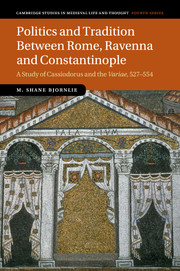Refine search
Actions for selected content:
23990 results in Ancient history
Chapter 2 - Timaeus’ life and works
-
- Book:
- Timaeus of Tauromenium and Hellenistic Historiography
- Published online:
- 05 February 2013
- Print publication:
- 13 December 2012, pp 17-42
-
- Chapter
- Export citation
References
-
- Book:
- Timaeus of Tauromenium and Hellenistic Historiography
- Published online:
- 05 February 2013
- Print publication:
- 13 December 2012, pp 268-288
-
- Chapter
- Export citation
Appendix B - Philodemus, On Poems and Timaeus T 15b
-
- Book:
- Timaeus of Tauromenium and Hellenistic Historiography
- Published online:
- 05 February 2013
- Print publication:
- 13 December 2012, pp 266-267
-
- Chapter
- Export citation
Acknowledgments
-
- Book:
- Timaeus of Tauromenium and Hellenistic Historiography
- Published online:
- 05 February 2013
- Print publication:
- 13 December 2012, pp ix-x
-
- Chapter
- Export citation
Contents
-
- Book:
- Timaeus of Tauromenium and Hellenistic Historiography
- Published online:
- 05 February 2013
- Print publication:
- 13 December 2012, pp vii-viii
-
- Chapter
- Export citation

Documentary Culture and the Laity in the Early Middle Ages
-
- Published online:
- 05 December 2012
- Print publication:
- 22 November 2012

Space and Society in the Greek and Roman Worlds
-
- Published online:
- 05 December 2012
- Print publication:
- 15 November 2012

Politics and Tradition Between Rome, Ravenna and Constantinople
- A Study of Cassiodorus and the Variae, 527–554
-
- Published online:
- 05 December 2012
- Print publication:
- 22 November 2012

The Social World of Intellectuals in the Roman Empire
- Sophists, Philosophers, and Christians
-
- Published online:
- 05 December 2012
- Print publication:
- 08 November 2012
Chapter 2 - The Age of Bureaucracy
- from Part II - Cassiodorus and the circumstances of political survival
-
- Book:
- Politics and Tradition Between Rome, Ravenna and Constantinople
- Published online:
- 05 December 2012
- Print publication:
- 22 November 2012, pp 39-59
-
- Chapter
- Export citation
1 - Introduction
-
- Book:
- Documentary Culture and the Laity in the Early Middle Ages
- Published online:
- 05 December 2012
- Print publication:
- 22 November 2012, pp 1-16
-
- Chapter
- Export citation
Abbreviations
-
- Book:
- Politics and Tradition Between Rome, Ravenna and Constantinople
- Published online:
- 05 December 2012
- Print publication:
- 22 November 2012, pp x-xi
-
- Chapter
- Export citation
9 - The laity, the clergy, the scribes and their archives: the documentary record of eighth- and ninth-century Italy
-
-
- Book:
- Documentary Culture and the Laity in the Early Middle Ages
- Published online:
- 05 December 2012
- Print publication:
- 22 November 2012, pp 231-258
-
- Chapter
- Export citation
Contents
-
- Book:
- Negotiating Identity in the Ancient Mediterranean
- Published online:
- 30 August 2021
- Print publication:
- 22 November 2012, pp v-v
-
- Chapter
- Export citation
Chapter 10 - Reading Good Governance in the Variae and the De Anima
- from Part III - Reading the Variae as political apologetic
-
- Book:
- Politics and Tradition Between Rome, Ravenna and Constantinople
- Published online:
- 05 December 2012
- Print publication:
- 22 November 2012, pp 283-305
-
- Chapter
- Export citation
Politics and Tradition between Rome, Ravenna and Constantinople - Title page
-
-
- Book:
- Politics and Tradition Between Rome, Ravenna and Constantinople
- Published online:
- 05 December 2012
- Print publication:
- 22 November 2012, pp iii-iii
-
- Chapter
- Export citation
Abbreviations
-
- Book:
- Documentary Culture and the Laity in the Early Middle Ages
- Published online:
- 05 December 2012
- Print publication:
- 22 November 2012, pp xi-xvi
-
- Chapter
- Export citation
Negotiating Identity in the Ancient Mediterranean - Title page
-
-
- Book:
- Negotiating Identity in the Ancient Mediterranean
- Published online:
- 30 August 2021
- Print publication:
- 22 November 2012, pp iii-iii
-
- Chapter
- Export citation
Introduction
-
- Book:
- Negotiating Identity in the Ancient Mediterranean
- Published online:
- 30 August 2021
- Print publication:
- 22 November 2012, pp 1-23
-
- Chapter
- Export citation
Copyright page
-
- Book:
- Politics and Tradition Between Rome, Ravenna and Constantinople
- Published online:
- 05 December 2012
- Print publication:
- 22 November 2012, pp iv-iv
-
- Chapter
- Export citation
